Men's magazines: an A-Z
Men's magazines,which may be lifestyle magazines, lad's magazines, glamour magazines, pin-up magazines or top-shelf magazines are covered on these pages:Introduction
- 3D titles to Boys Toys (this page)
- Carnival to Cut
- Deluxe to Esquire
- Fable to Front
- The Gentleman's Magazine to The Humorist
- Ice to London Opinion
- Man – to Maxim
- Mayfair to Monkey
- Nine to Playboy
- Razzle to Stuff
- T3 to Zoo Weekly
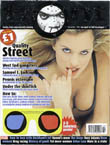 Front: launch issue of the men's magazine with 3D specs 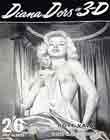 Diana Dors in 3D: number 3 in the Stereo Glamour series in the 1950s |
Men's magazines in 3DThis gimmick has been used from the 1950s through to the present day. In each case, the image is viewed through glasses with red/green lenses. Examples include:
|
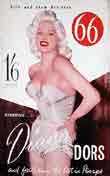 Diana Dors on the cover of 66
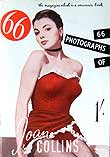 Joan Collins on the cover of 66 |
66 [closed]Town & Country Publications, Croydon, Surrey. 1956-Each issue featured a star of film or show business on the cover of this pocket publication. Examples included Diana Dors, Shirley Anne Field, Joan Collins, Brigitte Bardot and Marilyn Monroe. Its marketing line at one stage was: 'The magazine which is a souvenir book.' The company, known as 'Toco', published a range of pin-up titles, including Fanfare, Spick, Span and Beautiful Britons. Images from shoots sometimes appeared in more than one of the company's magazines, as the Joan Collins page demonstrates. |
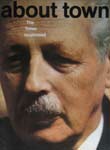 About Town (March 1961). Large format mainstream men's magazine.
The cover photograph of prime minister Harold McMillan was by
Terence Donovan. The art editor was Tom Wolsey |
About Town [closed]Cornmarket/ Haymarket, London, boughtMan About Town from Tailor & Cutter and abbreviated it to About Town, and later Town. Mainstream title that tried to avoid a pin-up approach (the company was - still is – owned by Tory politician Michael Heseltine). See dedicated Town pages All the Town covers |
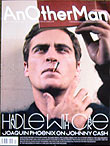 Joaquin Pheonix on the launch issue of Another Man
|
Another ManAnother Man Publishing, Autumn/Winter 2005-Jefferson Hack and Rankin Waddell – the duo behind Dazed and Another Magazine – publish this photograph-laden tome of men's fashion. The first issue included a 10-page shoot
of Kate Moss modelling Dior Homme's autumn clothes. It begins:
'She sells beer, she sells cigarettes and clothes...' She is
also Hack's former girlfriend and mother of their daughter. The
issue probably went to press before the 'Cocaine Kate' scandal
broke in the Daily Mirror because it carried Burberry advertising with Moss
– the company, along with others, dropped her over the controversy. |
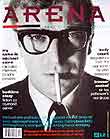 Arena – showing a typical men's magazine cover at the time, of Michael Caine (autumn 1988) 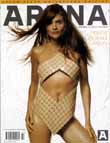 Arena – which kicked off modern men's magazines in 1986 – celebrates its 100th issue 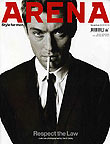 Jude Law mimicking Michael Caine in 2004 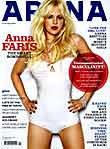 Arena's last issue dated April 2009 with US actress Anna Faris on the cover as ' the smart bombshell' photographed by Mattias Vriens |
Arena[Wagadon/Emap/Bauer, quarterly/monthly, Dec 1986 / Jan 1987-April 2009]Male readers who grew out of Nick Logan’s The Face had nowhere to go, so Logan thought up Arena as a quarterly, niche title, with an editorial mix of fashion, fads and fiction, and again designed by Neville Brody. It hit the streets in 1986. Logan was also a former editor of NME, founder of Smash Hits and had set up Wagadon with backing from Conde Nast. Peter Howarth, a later editor (1995-96) who increased the frequency from six to 10 issues a year, has said there was no conscious decision to make a male version of existing women's magazines. 'Nick Logan, launched The Face in 1980 because it was a magazine he wanted to read. But six years on he wanted to read a different magazine because he had moved on – as had all The Face readers – so he decided to do a men's magazine. It was never really a gap in the market; he just wanted to make the sort of magazine he wanted to read.' Other editors included Dylan Jones (1989), Kate Flett (1992), Ekow Eshun (1995), Greg Williams (1999), Anthony Noguera (2002-05), Giles Hattersley (2007) and Mat Smith (2008). Noguera was also editorial director when Arena closed.Sales never broke 100,000 and, like Esquire, Arena's sales trailed behind the leading men's fashion lifestyle title GQ, while FHM and Loaded fought it out for the mass market, with FHM selling 775,000 at its 1998 peak. In November 1988, the strain of having a second title led Logan to sell 40 per cent of his company, Wagadon, to Vogue publisher Condé Nast. He said at the time: 'The magazines are still under our control. But the deal will allow us to grow at a natural pace, knowing there's a cushion of support under us. It also takes away the administrative burden, which has doubled since the launch of Arena.'Arena sales rose to 66,500 copies an issue and became a spur for Condé Nast to launch a British edition of its US title GQ. Logan denied being formally involved. Condé Nast pulled out of Wagadon in the spring of 1999 and Logan had to sell the company to Emap. Yet, in March 2009, Bauer announced it was to close Arena. Its ABC sales figure was just 29,374 copies. Despite its pioneering history under Nick Logan at Wagadon, sales had slid since the sale to Emap and then since the Bauer takeover in 2008. The final issue went on sale 12 March (April cover date).Arena also published a bi-annual fashion special, Hommes Plus. International editions are published in Denmark, Ukraine, Turkey, Korea, Thailand and Singapore. Wagadon profile Emap profile |
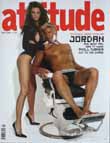 Jordan and Peter Andre on the cover of Attitude, a reference
to singer KD Laing being shaved in a barber's chair by model Cindy Crawford for the cover of Vanity Fair
|
AttitudeNorthern & Shell/SMD, April 1994-Monthly lifestyle magazine for gay men. SMD/Remnant profile |
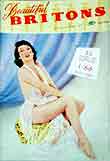 Beautiful Britons was full of glamour pin-ups in a pocket format. First issue above, issue 211 below 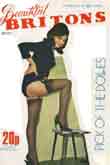 |
Beautiful Britons [closed]Town and Country Publications, 1955-1976 (252 issues)Pocket format pin-up magazine that called itself 'The magazine of eye appeal.' It specialised in photographs of ordinary women rather than models or film stars and published at least 250 issues. The company, which earned the nickname 'Toco', published a range of glamour magazines, including Spick, Span and 66. |
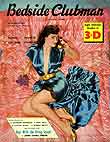 Bedside Clubman, volume 9 in about 1953 |
Bedside Clubman [closed]Bayard Productions (London 1951) Ltd, 30 Cork St, London W1. (?Nine issues 1951-53)Bedside Clubman was a large format, high quality magazine with a square spine. It cost 5/- and ran to 128 pages. The issue to the left has no dates. It was printed by Princedale Press, London, E1 and the editor was Maurice Moiseiwitsch. Its features included:
Bayard also published Clubroom. Princedale published Clubman. |
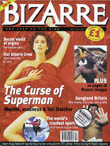 Bizarre, first issue, in March 1996 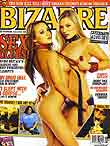 Bizarre, in March 2006 |
BizarreJohn Brown/IFG/Dennis, Mar/Apr 96-Viz and Fortean Times publisher John Brown came up with Bizarre in 1996. The main selling point was a 10-page section of bizarre images and news. Increasingly, though, the title focused less on the bizarre and more on its 'babe factor'; and bizarre sexual practices (particularly on its covers). Often comes with sealed section of classified 'adult' advertising. The first issue had legal problems and many copies appeared on
newsagents shelves with a page removed; a sticker on the cover
made a note of this. |
Blender (CD-Rom) [closed]Dennis, 1995?-Dennis launched this experimental CD-Rom in the mid-1990s (long before the title was used for its US music magazine). It only lasted a few issues. Dennis profile |
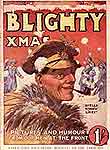 A colour Christmas special of Blighty (1916) 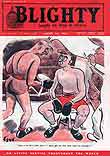 Blighty 's masthead during the war featured an illustration of the dome of St Paul's cathedral and the line 'Laughs its way to victory' (1944) 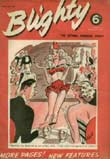 Blighty, a 6d A4-ish weekly (13 May 1950) 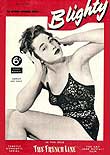 Shirley Ann Field was one of the biggest pin-ups of the 1950s. She featured on this 22 May 1954 cover and on at least two other occasions: 18 September and 28 January 1956 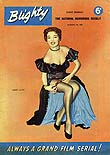 By August 1954, City Magazines had relaunched Blighty with a new cover design and colour pin-up cover. The leggy pin-up was Abbe Lane 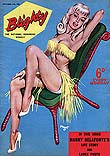 In 1958, Blighty ran several illustrated covers. These were signed MBT |
Blighty [closed]1916-1920; 21 October 1939 – 29 November 1958 (then see Parade)Humorous men's magazine that catered for the troops in the first world war was relaunched for the second. At various stages, Blighty branded itself with masthead straps such as: 'Laughs its way to victory' and 'On active service throughout the world' during the second world war. The magazine 'Laughed its way to victory', became the 'Forces choice, now Family Favourite', then 'The paper for all in every home' and the 'National Humorous Magazine'. Blighty used cartoon covers until it relaunched in the mid-1950s with a sub-A4 format and a colour pin-up cover (under City Magazines). Page 3 featured a near full-page cartoon by Arthur Ferrier. There was a 'Personal appearance for the ladies' page of a male film star and a Pin-up Parade page. A big feature of the magazine at this time was the serialisation of hit films as stories.The magazine was to undergo another evolution in the late 1950s and early 1960s, changing its title as it sought to focus on a male audience and at the same time move further away from its historical military base. The concept of the Pin-up Parade page appears to have been the inspiration for this:
|
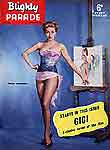 Blighty Parade, 11 April 1959 featuring a serialisation of the film Gigi |
Blighty Parade [closed]City Magazines, 45 St Pancras Way, NW1. Printed by Eric Bemrose, Long Lane, Liverpool 9.See Blighty |
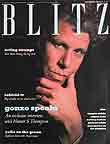 Blitz November 1988 |
Blitz [closed]Jigsaw Publications, September 1980-1991Launched just three months after The Face, and a month before i-D, by Carey Labovitch, Blitz was originally an arts magazine. However, like The Face, it broadened its coverage to create a new genre, the style sector, with the other two competitors. Blitz covers |
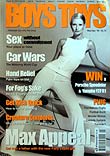 Boys Toys mixes lifestyle and women with gadgets and cars
|
Boys ToysFreestyle, Mar/Apr 99-Editor Kirsty Robinson put model Maxi Fielding on the first issue of this magazine with the strapline: ‘…because you only live once’. The magazine covers lifestyle, cars, fashion, sport, travel, style, women, bikes and gadgets. Freestyle profile |
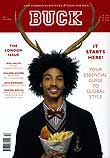 Buck mixes fashion with food and furniture to lay out a menu for the modern Dandy. Moustaches are definitely in (antlers optional) 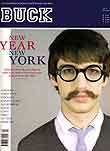 Frederick Blood-Royale shows Buck readers round New York 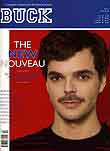 Is Buck going more mainstream with Quentin Delafon, lead singer of Parisian synth-rockers The Teenagers on the cover? |
BuckBuck Publishing Ltd, London. Men's lifestyle; monthly. October 2008 (December cover date)-2009Editor and publisher Steve Doyle put his own cash behind this maverick title. Rather than aiming at City slickers, Buck saw itself as for the more creative man, who was happy to burnish his own image, instead of buying one off a shelf through GQ. Moustaches were a big feature in the style shots. Buck man may have a few gaps in his practical knowledge though, so the magazine's cookery pages explained how to stock a larder and use it (à la Len Deighton I like to think) and put up shelves. There's a much bigger focus on cheffery than other titles – an area identified as being poorly serviced as long ago as 1996 when the Loaded team launched the short-lived food magazine Eat Soup. The magazine survived as a website, for a while. |



